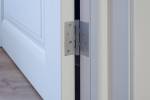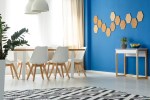Right design key to making home office useful, comfortable
Which parts of the home get the most use? The answer depends on who’s asking the question.
For example, a group that sells bathroom products recently announced that — you guessed it — more hours are spent in the bathroom than anywhere else, with the exception of the bedroom.
Now comes ORG Home Organization, a company specializing in storage products, with the claim that the home office is “the second most used area in the house” — right after the kitchen.
I have no idea who’s right about these usage patterns. And it actually doesn’t matter because, to me, the real issue is how best to design a particular space, regardless of the amount of time spent there.
But I do know that ORG is correct in suggesting that home offices are often a mess. So let’s consider what might be done about that.
Q: As part of a planned renovation, we’re considering converting an unused maid’s room into a home office. Another option is to leave the space unchanged and use it as a catchall activities room.
That’s my husband’s preference, but I’m sure the clutter would quickly become unmanageable — and unsightly too. Help me argue in favor of the home-office alternative. Please offer some suggestions for an attractive design that I can then present to my husband.
A: I don’t want to play the role of referee, but it’s true that a home office can easily be made to function as a well-organized space — which can never be the case, by definition, with a catchall activities room.
The first thing to consider is how many people will use a home office. The larger the number, the greater the need for storage units. Stowing stuff efficiently is the key to an attractive design for any home office.
The actual look of such a space is a matter of personal taste. You can furnish it in the style of a 19th century library, for example, but the success of the design will ultimately depend on how you arrange the computer, the printer, the scanner and all the other electronic equipment and filing systems used in a 21st century home office.
I recommend that you draw up a detailed layout showing where these items are to be situated. It should also take account of lighting concerns, which are often overlooked in home offices.
Be sure to include task lighting as well as ambient lighting that will help make working conditions pleasant both in the daytime and at night. The decision on where to position a computer should also be based in part on lighting factors. Guard the screen against glare from either indoor or outdoor sources.
The room should also be insulated from noise in adjacent spaces.
Combine all these considerations, add some flair, and the result may be a home office as highly functional and as good-looking as the one shown in the photo. ORG (www.orghomesolutions. com) designed this model with clean lines and coordinated finishes. But note how the contemporary look is softened by an area rug and some homey accessories.
The desk and side-extension cabinetry are joined with the credenza against the wall in an L-shaped configuration. This layout keeps the printer and office supplies off the tidy desk yet within easy reach.
One subtle touch worth emulating is to affix a wire tray to the underside of the desk. It allows the electrical cords and cables present in every home office to be arranged into something other than a tangle at one’s feet.
Rita St. Clair is a syndicated columnist with Tribune Media Services Inc. E-mail general interior design questions to her at rsca@ritastclair.com.


















